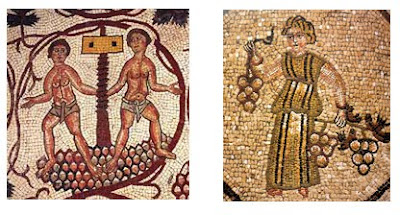Ciotole dai tronchi d'albero... In recent years we see more and more projects that relate to wine cellars with its museums and companies. These architectures of wine, or as they are called "cathedrals of wine", most often are constructed as underground structures, a bit 'to preserve the quality of wines, thus reflecting the old and traditional wineries, too, a bit' to try to blend in a context like that of the vineyards, which is always a work of man since ancient times by the fascinating landscape point of view.

-Marchesi Antinori winery, designed by
archaea Ass ociati , si inserisce perfettamente nel luogo, un'area del Chianti tra Firenze e Siena, lasciando visibili solo due tagli orizzontali che si sviluppano lungo le curve di livello ricoperte da vigneti che racchiudono gli altri cinque piani sottoterra.
Dalle fenditure orizzontali si può vedere l'interno ipogeo: in quella superiore vi sono le zone per l'imbottigliamento e quelle dei magazzini, in quella inferiore gli uffici che si affacciano sul luogo.

Nella sezione interrata, costituita da volte in terracotta, si conservano i vini, una scelta legata alle condizioni termo-igrometriche che bisogna rispettare per una corretta conservazione del prodotto.
Le volte cambiano their height according to the production process, the location that the grapes are from the barrel fermentation underground silos.

Visitors Instead, starting from the underground cellars, comes to the places of production and exhibition where you can find the mill, a library, a tasting area, and the other groups who receive it.
As you can see, a winery that complies with both the project and with the materials used in the natural environment of the place, and traditional techniques.

Different approach was made at the winery
Tramin Werner Tscholl Termeno in South Tyrol, where the outside, clearly visible, seems to draw the lattice of the vineyards like many branches that are intertwined.
The project was carried out on the original store and did not lose any ground to the vineyards, this was a plus for the selection of the project.

existing building will stretch from the two bodies of the new project hosting the wine cellar and tasting room, and from these areas, the visitor has a privileged panoramic view over the vineyards.

winery Weingut
Manincor architect Walter Angonese among the rolling hills of Lake Caldaro, Alto Adige, is also an example of underground architecture, almost Invisible among the vineyards, which respects the spirit of the place.

The winery, built in a vineyard east of the original complex, is now joined to it naturally. In it, the conditioning is done through the walls and through openings created specifically for the exchange of air. The cement used for the underground areas has a color that recalls the lime plaster walls of the vineyards, and give an oxidized steel with an antique flavor to the whole project. The architect himself stresses the fact that he was inspired by the idea that design is "to build in continuity."

and concludes with the
in Cascina Adelaide Barolo, the architect Ugo Della Piana. The structure consists of an artificial mound that contains the underground cellars, also a project that blends in the context of the vineyards.


The various structural parts made of glass and steel mimic the natural elements of the place, the basement area is largely surrounded by glass, so that the visitor, once entered, can observe 'outside and still feel surrounded by nature.

Virtually increasingly seen to be born in Italy these cellars copyright. I wanted to bring back those that seemed to adhere more closely to the context, in relation to others, although signatures of famous, not naturally fit in our own vineyards.
Many are the copyright wineries that have sprung up in recent years in different countries, but I preferred to leave only a trace of our architecture.



 Questo è un mio omaggio alla zucca, con etichetta Pantone 021C
Questo è un mio omaggio alla zucca, con etichetta Pantone 021C 
 These pumpkins are instead Alessandro Amato artist who made the original lamps. Shell carving of pumpkins was able to obtain special effects inserted a light inside. The artist uses pumpkins
These pumpkins are instead Alessandro Amato artist who made the original lamps. Shell carving of pumpkins was able to obtain special effects inserted a light inside. The artist uses pumpkins  designer Laurel Young has indulged in proposing the pumpkins on its cups, two colors, black and orange, showing both inside and outside designs.
designer Laurel Young has indulged in proposing the pumpkins on its cups, two colors, black and orange, showing both inside and outside designs. 

 And finally we also have a pumpkin-bag Dona and
And finally we also have a pumpkin-bag Dona and  hats shaped pumpkin Leigh-Anne .
hats shaped pumpkin Leigh-Anne . 





























